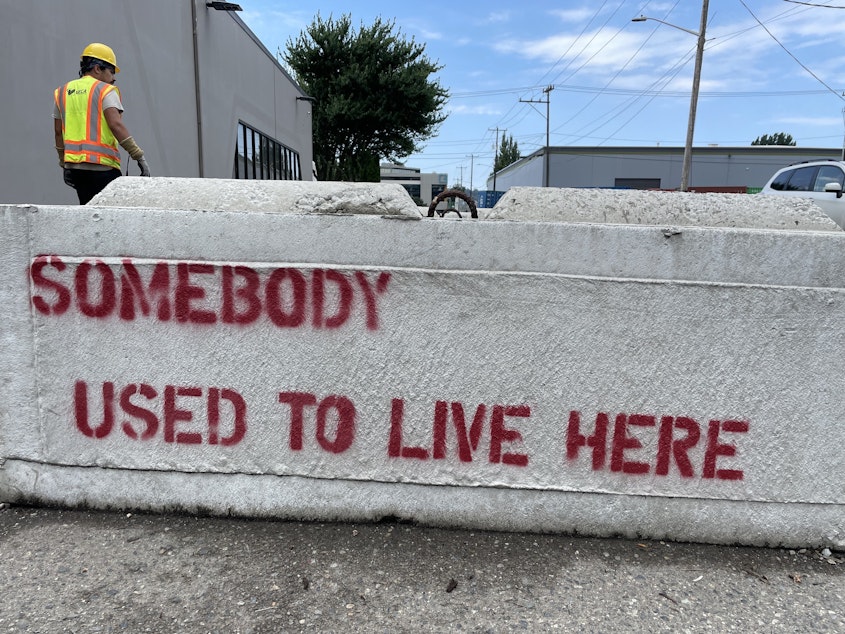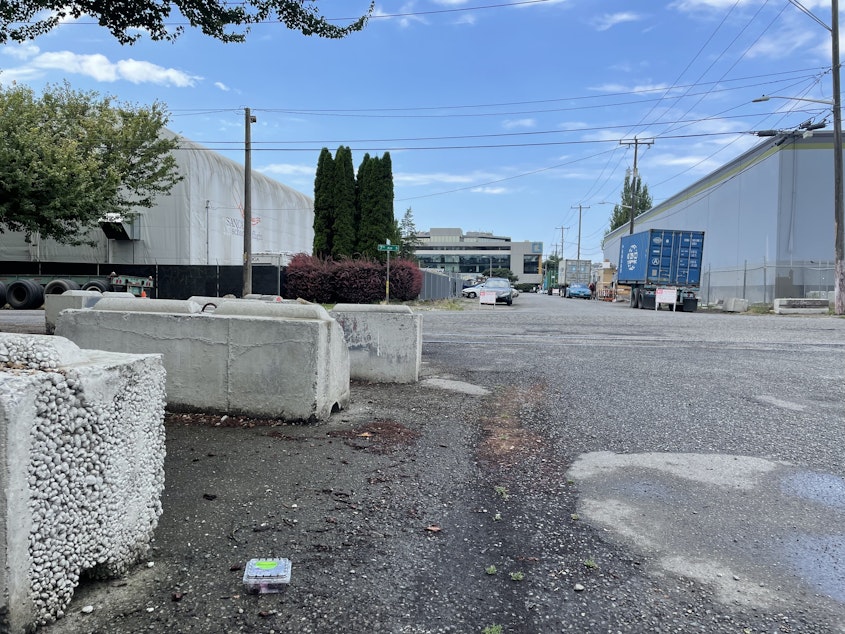An increase in eco-blocks signals a battle between parking and encampments

Ecology blocks are large slabs made from recycled concrete, with grooves on the top and bottom to help form retaining walls.
But on city streets and sidewalks, they form a different kind of barrier: Deterring RVs and encampments, which have proliferated in Seattle during the pandemic.
Joe Ingram pulls up next to a long row of ecology blocks on 5th Avenue in Georgetown, just outside the Sur La Table corporate headquarters.
"This used to be all RVs, and a mess," he said.
Ingram works in homelessness outreach with the Interfaith Task Force on Homelessness, which partners with a bevy of homelessness services in Seattle and King County, including the King County Regional Homelessness Authority and Seattle's HOPE team.
This stretch of 5th Avenue and Michigan Street was recently swept by the city.
"The next day I came by and they were putting the blocks out," Ingram explained. "And the parking enforcement had blocked both ends of the street. So no one could drive down here so they could clean up the residual mess. But at the same time, all these blocks went up."
Sponsored
Placing eco-blocks on public property without a permit is illegal. But on street after street, dozens of eco-blocks line the side of the road.
In an email, Seattle’s Department of Transportation (SDOT) gave the following statement when asked about the proliferation of eco-blocks:
It is unlawful to place objects or structures in a public place without a permit, and SDOT does not issue permits to obstruct public streets, sidewalks or parking spaces with concrete blocks.
When we are notified about a concrete block on a public street or sidewalk, our response is to send warnings to the adjacent property owners and businesses notifying them that if they placed the concrete blocks then they have legal responsibility to remove them to avoid a citation.
It is not always clear who was responsible for the concrete blocks, so our objective is to correctly identify the responsible party and work collaboratively if they are willing. We encourage them to take responsibility for removing the unauthorized obstructions and to find a solution that works well for everyone.
Sponsored
Soundside reached out to businesses with blocks outside around 5th, 6th, and 7th avenues in Georgetown, but was unable to speak with any owners on the subject before publication.
Hear one business owner's reaction to eco blocks and where they come from by clicking here.


Ingram says blocks are appearing in a predictable pattern: Once the city finishes sweeping encampments and RVs from a street lined with businesses, a row of eco-blocks quickly pops up.
Georgetown and Sodo have long attracted RVs because of industrial zoning laws that allow for overnight parking, up to 72 hours.
Sponsored
At the beginning of the pandemic there was a moratorium on parking enforcement, so people living in their vehicles could stay indefinitely.
Last fall, the city announced it would once again be sticking orange tags on windshields and unoccupied vehicles. Then in May, SDOT announced it was returning to a pre-pandemic level of enforcement – requiring cars and RVs to move every 72 hours, or risk getting impounded.
The shift comes as Mayor Bruce Harrell's administration has stepped up encampment sweeps and pledged to identify more shelter beds and affordable housing units, with the goal of bringing more people indoors.
"I believe, and by his actions, that the mayor and his administration have declared war on people that are homeless and living in vehicles," Ingram said. "Because they're relentless, they're unforgiving, noncompromising, and they don't care. They stand up and say, we're offering these people shelters and housing, and they're not taking it."
In its announcement, SDOT said people living in vehicles would be given warnings and offers of information about support services.
Sponsored
Homeless encampment removals are operated by a collection of departments: Seattle Public Utilities, Seattle Police, Parks and Recreation, contracted outreach workers, and the King County Regional Homelessness Authority.
If residents haven't cleared belongings by the time of a removal, or if vehicles can't be moved because they're inoperable, they're towed or impounded.
At an encampment near 7th Avenue and Findlay Street, a woman named Megan said she's lived in this location for the last three years. Before that, when parking enforcement was at pre-pandemic levels, she stayed at a location for an average of three days. If she was lucky, she could stay at a location for two weeks.
Megan said she understands why business owners feel frustrated with encampment sizes today, and why they might opt for eco-blocks despite the legal risk.
At the same time, she sees a double standard as the city regularly removes illegal encampments but not illegal eco-blocks. Megan said that sends a clear message to those who are eking out a life on the street.
Sponsored
"People make you feel like trash, and it hurts," she said. "I have a good background, I've had everything, I've lived a good life. I like to be out here, so I'm not trash. I am houseless, but I'm not homeless — I have a home."

As reported by Amanda Zhou in The Seattle Times, there was a set of eco-blocks removed on Southwest Andover Street in the Delridge neighborhood, in West Seattle. Nucor Steel took responsibility for placing the blocks after a warning in June, and the company oversaw their removal.
Ingram noted, however, that he hasn't seen eco-block removal in areas of South Seattle.
"Everyone seems to be arguing about letting RVs stay, and I think we should be focused on helping people make sure their RVs are moveable so they can comply with the 72 hour law and be a good neighbor," said Erin Goodman, the executive director of the SODO Business Improvement Area.
The Business Improvement Area is a nonprofit organization that collects funds from local businesses and property owners to fund services that the city doesn’t provide, including street cleaning ,transportation, and safety issues.
Goodman said she counsels businesses that eco-blocks are not permitted, but understands why people are choosing to place them.
"Businesses in SODO have very little control over parking or what's happening right up next to literally touching their building," Goodman said. "We see every year numerous fires from RVs and some of these jump to the neighboring building because of the proximity. We also see situations where businesses are literally surrounded. They can't do their operations because every single space around their building is blocked by an RV."
Goodman says that the situation in Georgetown and SODO requires a nuanced approach, with specific programs to address the buildup RVs, cars, and tents.
"If we continue to use a broad brush in describing all people who do not have a home in the same manner, we will never get to the root of the solution," she said.
In June, Soundside spoke with two proponents overseeing safe parking lot programs in Tacoma and Seattle. Seattle's pilot program will just house RVs, and will be overseen by the Low Income Housing Institute (LIHI). In an email, LIHI's Jon Grant sent the following update:
We are still in the process of finding a site for the program, we have reviewed about a dozen locations and have been in discussion with a few of the property owners. We are looking for a site that is approximately 45,000 square feet to serve about 35 RVs at any given time, or about 50 RVs each year. The program has a strong and robust housing search component with dedicated onsite case managers that will prioritize getting people out of their RVs and into permanent housing. This will not just be a parking lot, but a service rich environment that can move people into stable living situations. Our goal is to have secured a site and opened the program before winter, but again that will be dependent on securing a location first.
Tacoma's program currently connects those living in vehicles with local religious organizations, which supervise parking programs on their lots and provide additional food and sanitation services.





